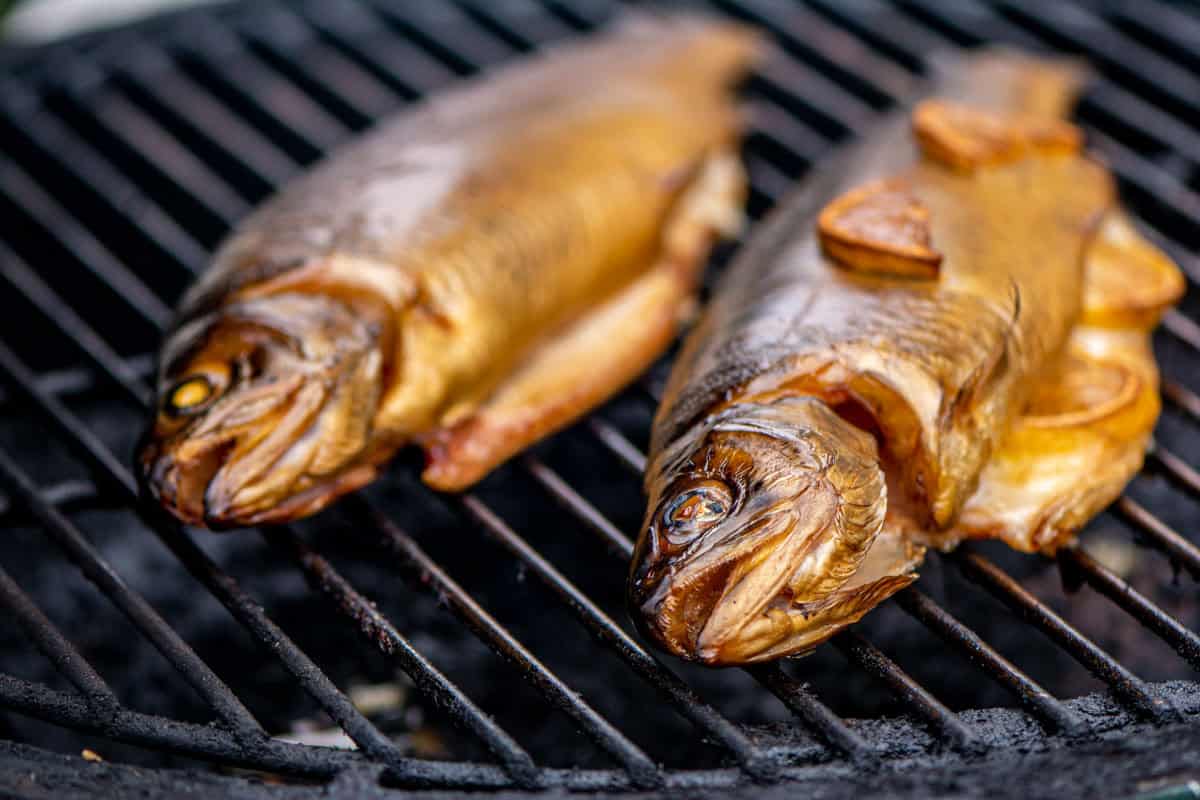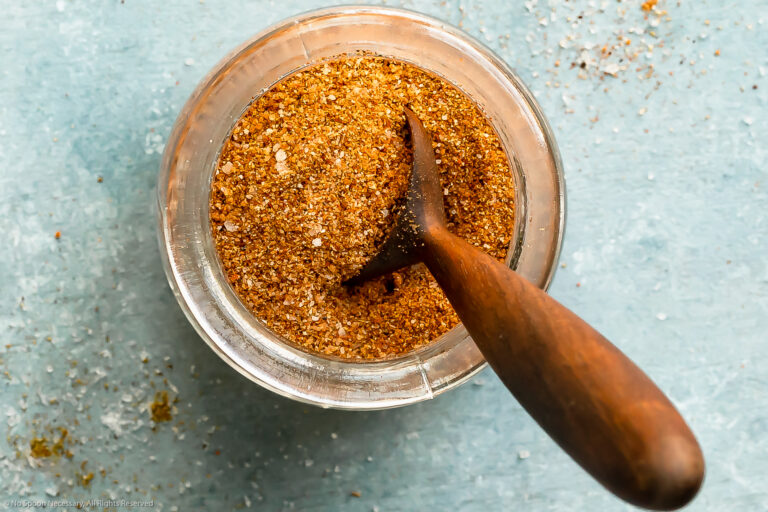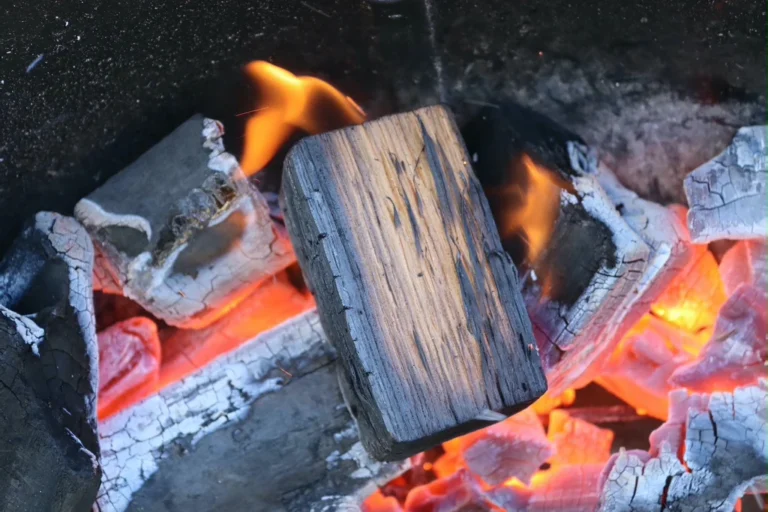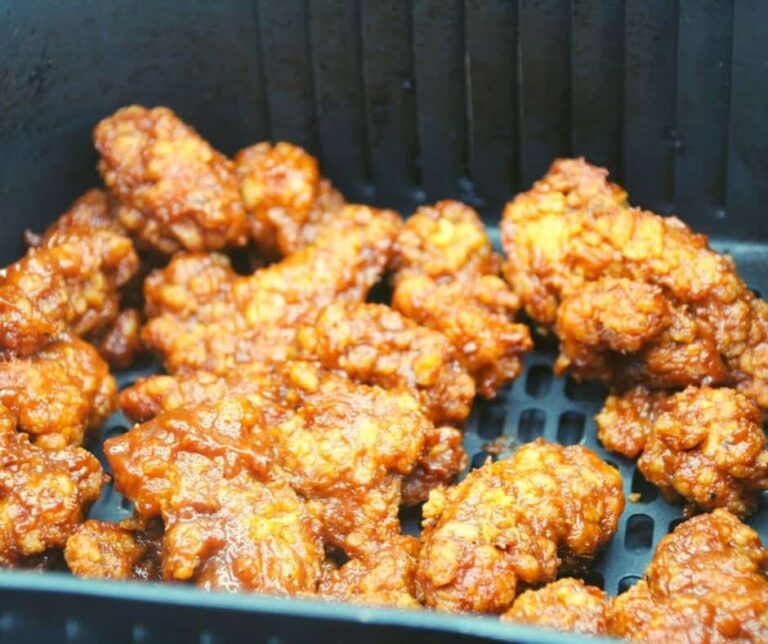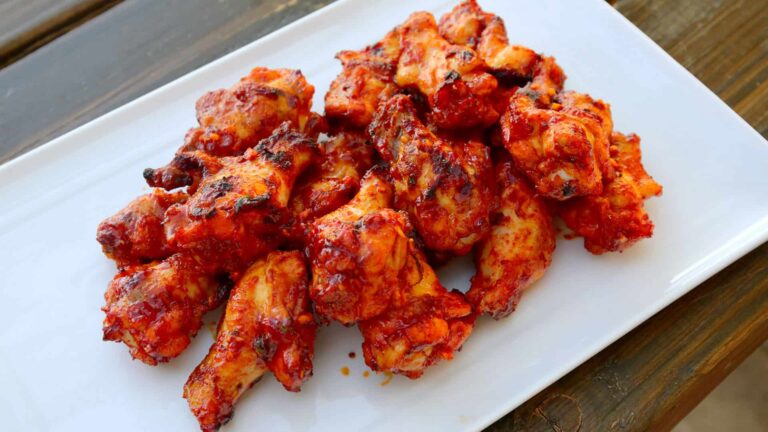Beginners Guide to Smoked Trout
Picture this: A cool, crisp evening, the sun setting, and the irresistible aroma of smoked trout wafting through the air. Whether you’re a seasoned angler or a curious foodie, smoked trout is the perfect blend of tradition and culinary delight that brings everyone to the table.
In this guide, we’re diving deep into the world of smoked trout. We’ll walk you through everything from selecting the freshest fish to serving up the most delicious smoked delicacies. By the end, you’ll be equipped with all the knowledge and confidence you need to smoke trout like a pro.
We’ll explore the difference between hot smoking and cold smoking, share the best practices for brining and smoking, and provide some tantalizing recipes to elevate your smoked trout game. So, grab your smoker, and let’s get started on this flavorful journey!
What is a Smoked Trout?
Smoked Trout: Smoking trout is a culinary technique that involves preserving and flavoring fresh trout by exposing it to smoke from smoldering wood chips or herbs. This process imparts a distinctive smoky aroma and flavor to the trout, resulting in a delicious, tender, and savory fish that can be used in a variety of dishes, from salads and appetizers to main courses.

Historical Background:
Smoking fish is an age-old preservation method that dates back centuries. Indigenous cultures and early settlers used smoking to preserve their catch for the winter months. Today, while we have modern refrigeration, smoking remains a beloved technique for enhancing the flavor of fish.
Nutritional Benefits:
Smoked trout is not just tasty but also nutritious. It’s packed with protein, omega-3 fatty acids, and essential vitamins and minerals. Incorporating smoked trout into your diet can support heart health, brain function, and overall well-being.
- High Protein Content: Excellent for muscle repair and growth.
- Omega-3 Fatty Acids: Essential for heart health, brain function, and reducing inflammation.
- Vitamins and Minerals: Packed with B vitamins, vitamin D, selenium, and phosphorus, supporting overall health and well-being.
Reasons You Need to Know How to Smoke Trout
Smoking trout isn’t just a culinary skill; it’s a gateway to a world of gourmet possibilities. Here are some compelling reasons why mastering the art of smoking trout is essential:
- Elevate Your Culinary Repertoire: Adding smoked trout to your cooking arsenal allows you to create sophisticated and impressive dishes that will amaze your friends and family.
- Cost-Effective Delicacy: Making your smoked trout at home is not only satisfying but also cost-effective compared to ordering it in restaurants.
- Healthier Options: When you smoke trout yourself, you have control over the ingredients and can opt for healthier preparation methods.
- Impress Guests: Whether you’re hosting a dinner party or a brunch gathering, serving homemade smoked trout demonstrates your culinary prowess and leaves a lasting impression.
- Versatile Ingredient: Smoked trout can be used in salads, pasta, sandwiches, or as a standalone dish, making it a versatile addition to your cooking repertoire.
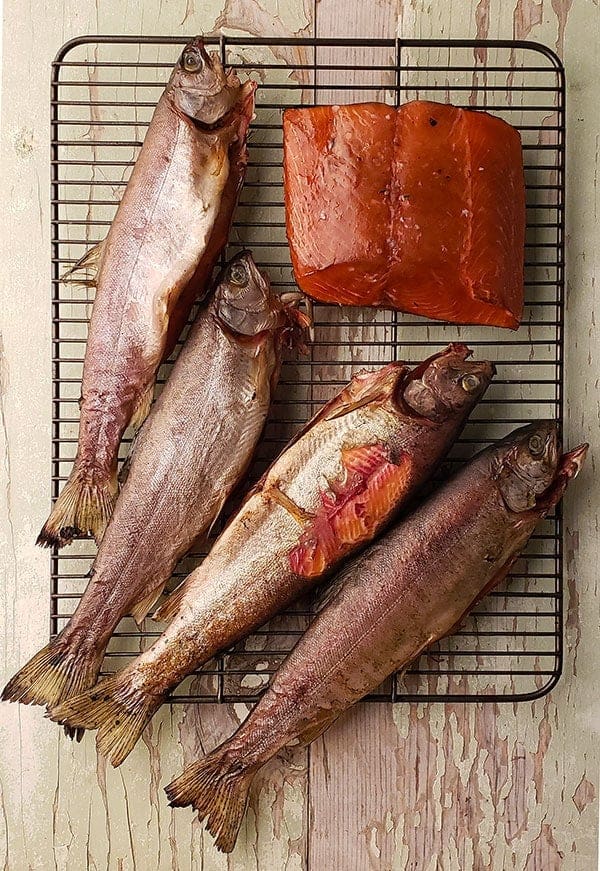
Preparing to Smoke Trout
Now that we know what smoked trout is and its benefits, let’s gear up for the actual smoking process. This section will cover everything you need to get started, from selecting the right trout to preparing it for the smoker.
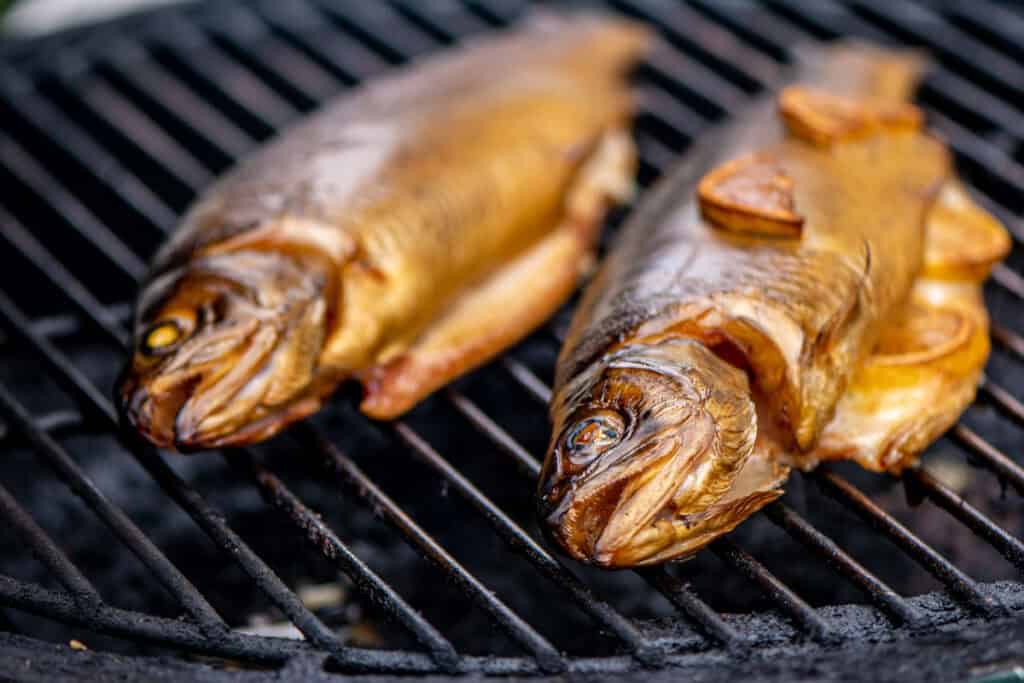
Choosing the Right Trout:
When it comes to smoking trout, the fresher, the better. Here are a few tips on selecting the best trout for smoking:
- Freshness: Look for bright, clear eyes and firm flesh. The fish should have a fresh, mild scent.
- Size: Medium-sized trout (about 12-16 inches) are ideal as they fit well in most smokers and cook evenly.
- Type: While rainbow trout is a popular choice, brown trout and brook trout also work well. Opt for wild-caught if possible, as they tend to have a firmer texture and richer flavor.
Essential Equipment:
Before you start, ensure you have the following equipment:
- Smoker: You can use electric, gas, charcoal, or wood smokers. Each type has its unique advantages, but they all get the job done.
- Fillet Knife: A sharp, flexible knife is essential for filleting the trout cleanly.
- Wood Chips: Alder, apple, and cherry wood chips are excellent choices for smoking fish, providing a mild, sweet smoke that complements the trout’s flavor.
- Thermometer: A reliable meat thermometer helps monitor the internal temperature of the fish to ensure it’s properly cooked.
Ingredients for Brining:
Brining is a crucial step in the smoking process, as it enhances the flavor and helps the fish retain moisture. Here’s a basic brine recipe to get you started:
- Salt and Sugar: The core components of any brine. Kosher salt and brown sugar are commonly used.
- Water: Enough to completely submerge the fish.
- Optional Additions: You can add various herbs, spices, and aromatics such as garlic, bay leaves, peppercorns, or citrus slices to infuse additional flavors into the trout.
Basic Brine Recipe:
- 1 quart of water
- 1/4 cup kosher salt
- 1/4 cup brown sugar
- Optional: 2 cloves of garlic, 1 bay leaf, 10 peppercorns, a few slices of lemon
Step-by-Step Guide to Smoking Trout
1. Select the Perfect Trout:
Begin by choosing fresh, whole trout or fillets from a reputable source. Ensure they are properly cleaned and scaled.
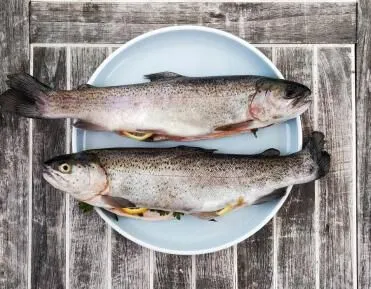
2. Brine Magic:
Create a simple brine solution using water and kosher salt. Immerse the trout in the brine for 30 minutes to 1 hour, enhancing flavor and moisture.
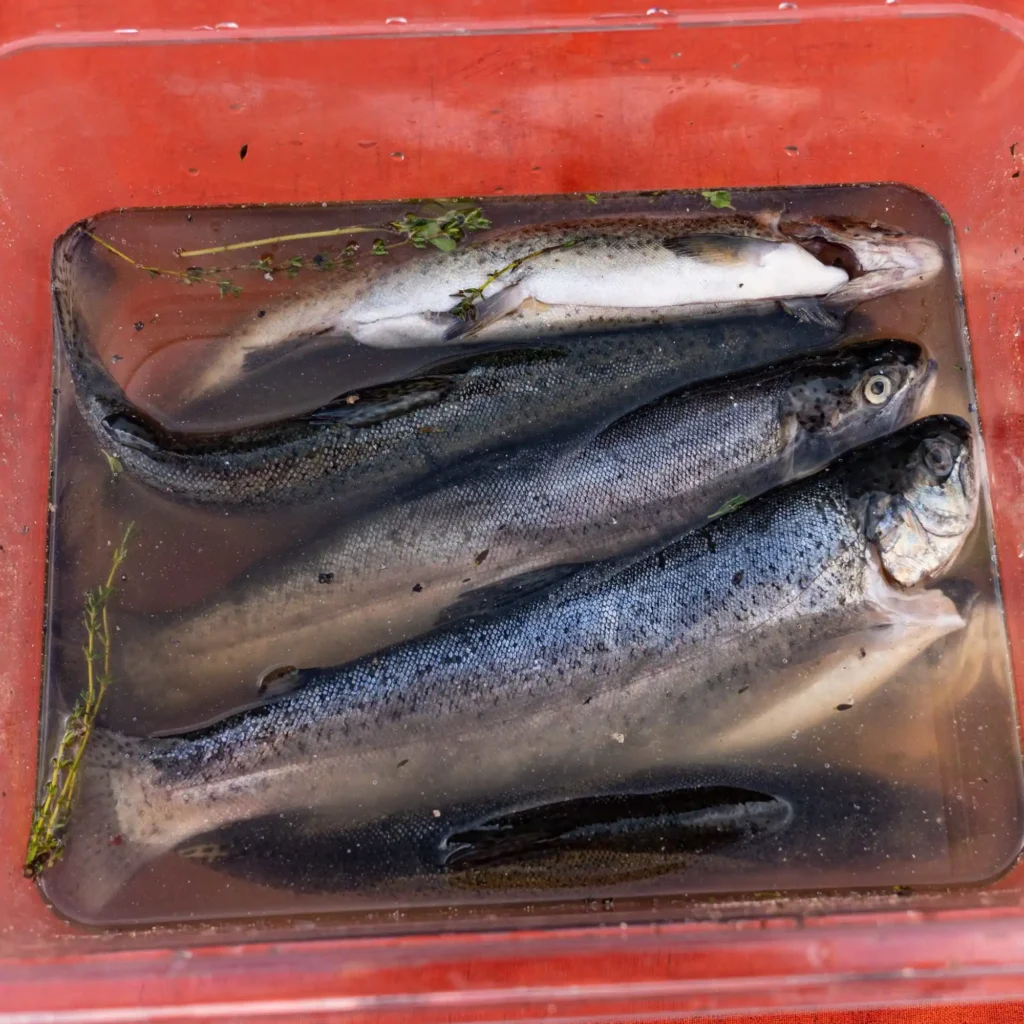
3. Rinse and Pat Dry:
Remove the trout from the brine,
rinse it thoroughly under cold water, and pat it dry with paper towels.
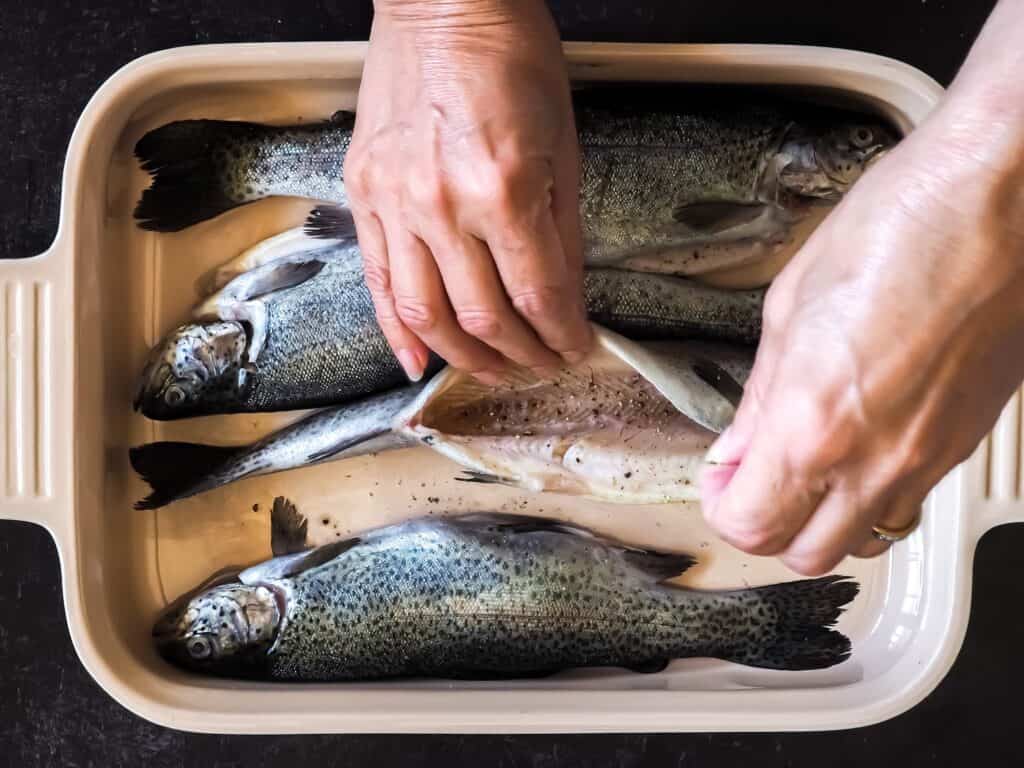
4. Seasoning Symphony:
Sprinkle seasonings, such as black pepper, garlic powder, and paprika, evenly over the trout’s surface. This step adds depth to the flavor profile.

5. Prep the Smoker:
While the trout marinates, preheat your smoker to a temperature of 225-250°F (107-121°C). Add the chosen wood chips to generate that irresistible smoky aroma.
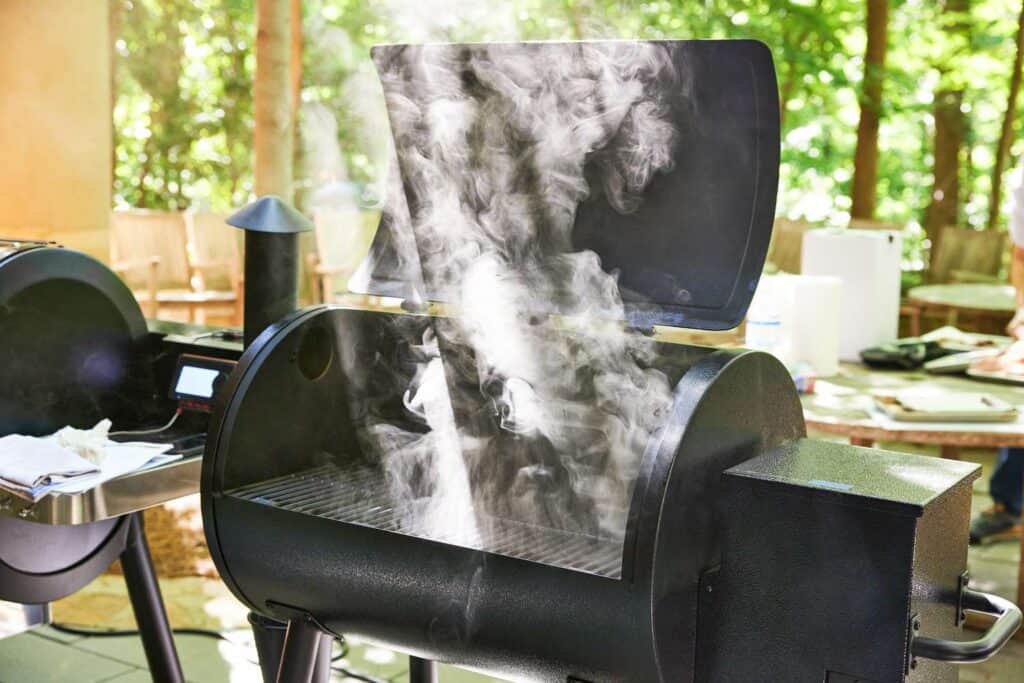
6. Trout on the Grill:
Place the seasoned trout on a trout grate
or rack, ensuring they are not too close
together for proper smoke circulation.
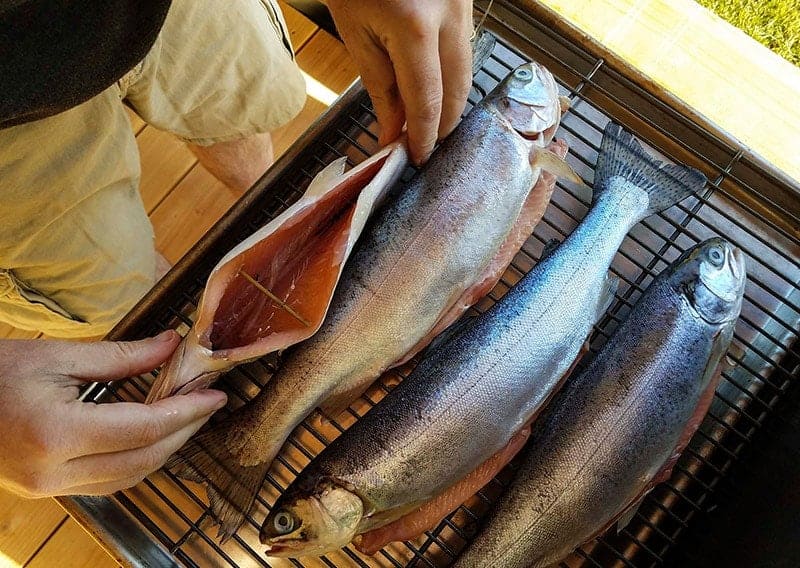
7. Smoking Serenade:
Carefully transfer the trout to the preheated smoker and maintain a consistent temperature. Smoke the trout for 1-2 hours or until it reaches an internal temperature of 145°F (63°C).
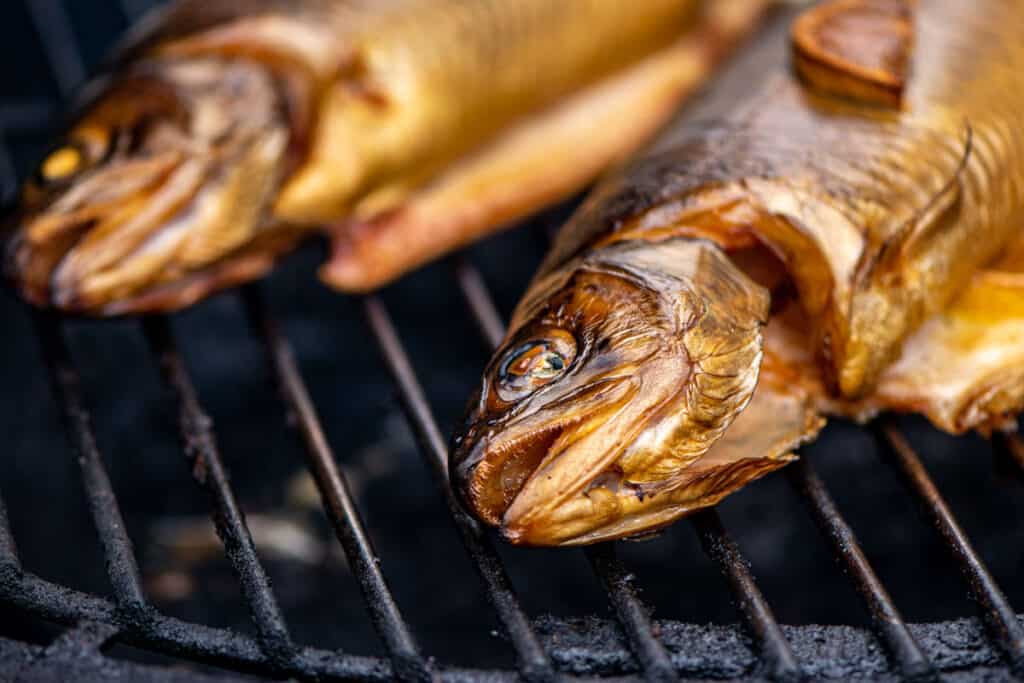
8. The Beauty of Basting:
Periodically baste the trout with a mixture of
olive oil and herbs using a basting brush.
This keeps it moist and adds a delightful
shine.
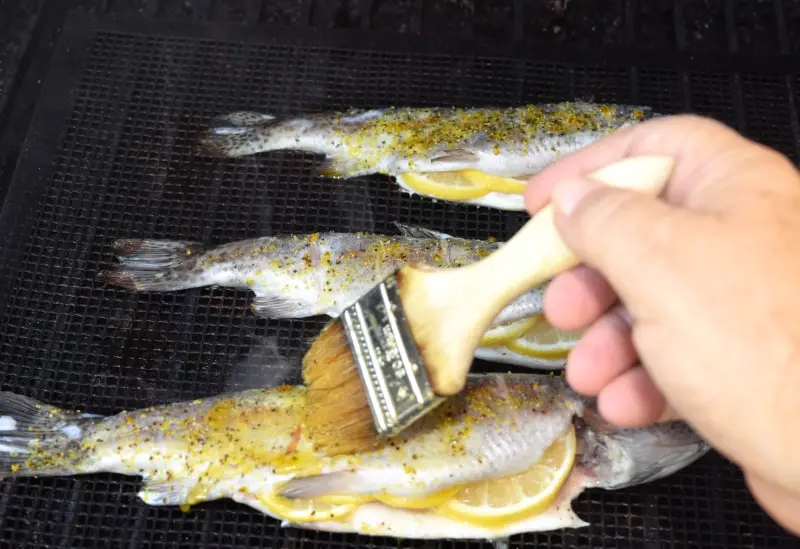
9. Finish with Finesse:
Once the trout reaches the desired doneness, remove it from the smoker. Let it rest for a few minutes, allowing the flavors to meld.
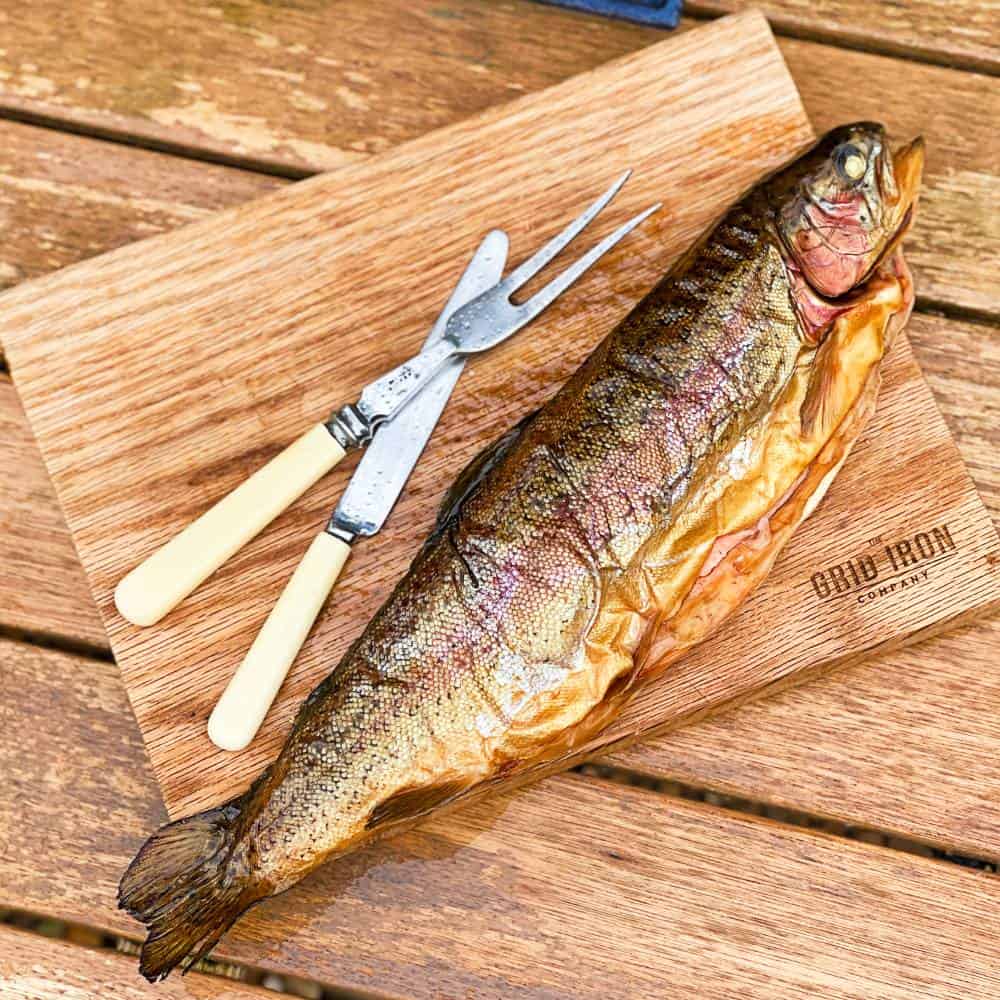
10. Serve and Savor:
Plate your smoked trout with a garnish of fresh herbs and citrus slices, like lemon or orange, for a burst of aroma and presentation. Enjoy!
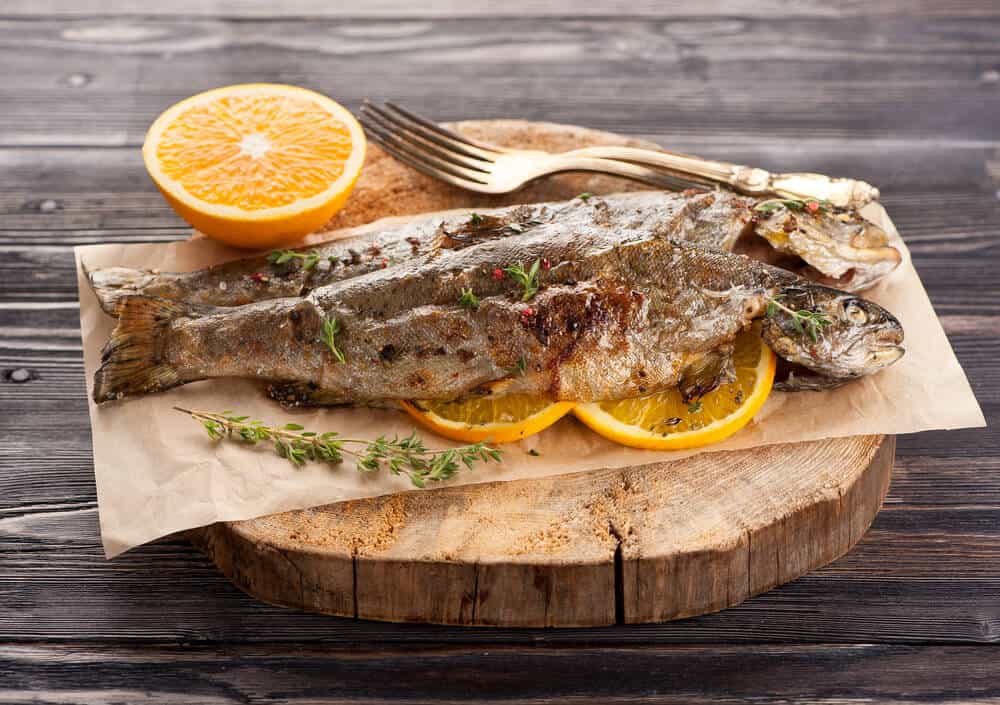
Serving and Storing Smoked Trout
Now that your trout is perfectly smoked, let’s talk about the best ways to serve and store it. This ensures you get the most out of your delicious creation.
Serving Suggestions:
Smoked trout is incredibly versatile and can be enjoyed in various ways:
- As Is: Serve the smoked trout fillets warm right out of the smoker, or chilled. A simple squeeze of lemon juice can enhance its smoky flavor.
- With Accompaniments: Pair the trout with crusty bread, cream cheese, red onions, and capers for a classic combination.
- In Salads: Flake the smoked trout and toss it into a fresh green salad, or a pasta salad, for a protein-packed, flavorful addition.
- Smoked Trout Dip: Mix flaked smoked trout with cream cheese, a splash of lemon juice, and some fresh herbs for a delicious dip.
- In Dishes: Incorporate smoked trout into recipes like quiches, frittatas, or pasta dishes to add a rich, smoky flavor.
Storage Tips:
Proper storage will help maintain the quality and safety of your smoked trout:
- Refrigeration: If you plan to consume the smoked trout within a few days, store it in an airtight container in the refrigerator. It will stay fresh for up to a week.
- Freezing: For longer storage, remove the skin and bones, then wrap the trout tightly in plastic wrap or aluminum foil, and place it in a freezer-safe bag. Smoked trout can be frozen for up to three months. Thaw it in the refrigerator before using.
- Vacuum Sealing: If you have a vacuum sealer, use it to store smoked trout for extended freshness. Vacuum-sealed smoked trout can last up to six months in the freezer.
Recipes and Pairings:
Here are a few simple recipes and pairing ideas to inspire your next meal:
- Smoked Trout Pâté: Blend smoked trout with cream cheese, a bit of horseradish, and fresh dill. Serve with crackers or toast points.
- Smoked Trout and Avocado Salad: Combine smoked trout, diced avocado, cherry tomatoes, red onion, and arugula. Dress with olive oil, lemon juice, salt, and pepper.
- Smoked Trout Pasta: Toss flaked smoked trout with cooked pasta, olive oil, garlic, cherry tomatoes, and fresh basil. Finish with a sprinkle of parmesan cheese.
Troubleshooting Common Issues
Even with the best preparation, smoking trout can sometimes present challenges. Here’s a guide to troubleshooting common issues you might encounter and tips to ensure your smoked trout turns out perfect every time.
Problem: The smoked trout is dry and lacks moisture.
- Solution: Ensure the smoker temperature is not too high. Keep it between 180°F to 200°F. Brining helps retain moisture, so don’t skip this step. Additionally, do not overcook the fish; remove it from the smoker once it reaches an internal temperature of 145°F.
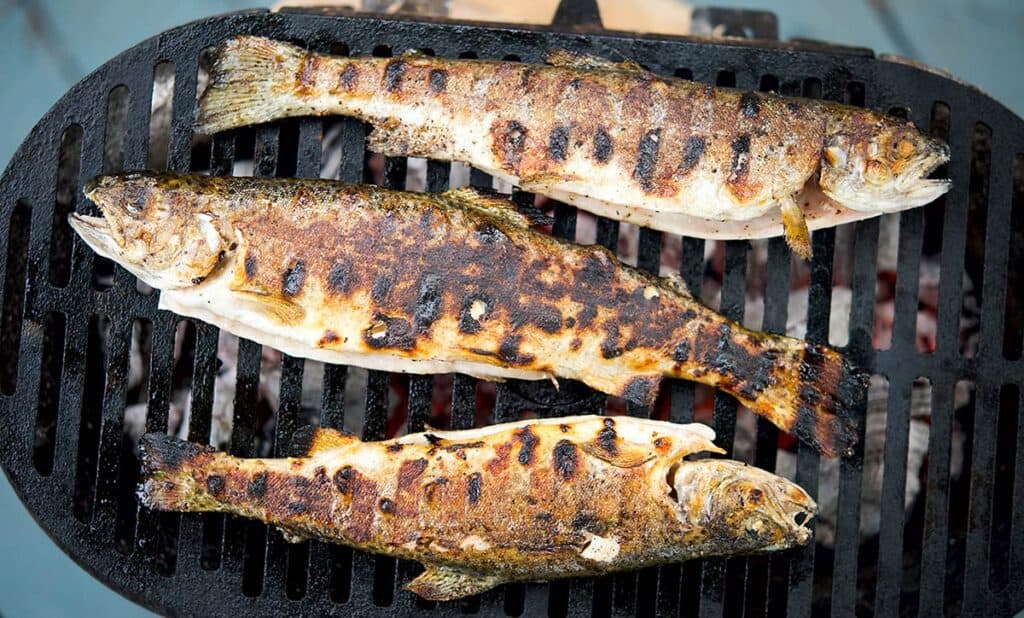
- Dry Fish:
- Problem: The smoked trout is dry and lacks moisture.
- Solution: Ensure the smoker temperature is not too high. Keep it between 180°F to 200°F. Brining helps retain moisture, so don’t skip this step. Additionally, do not overcook the fish; remove it from the smoker once it reaches an internal temperature of 145°F.
- Uneven Smoking:
- Problem: Some parts of the trout are more smoked than others.
- Solution: Arrange the fillets evenly on the smoker grates, ensuring enough space between each piece for the smoke to circulate. Rotate the fillets halfway through the smoking process if needed.
- Bitter Flavor:
- Problem: The smoked trout has a bitter taste.
- Solution: This can result from using too much smoke or using the wrong type of wood. Use mild woods like alder, apple, or cherry. Avoid resinous woods like pine. Ensure the wood chips are producing clean, thin smoke rather than thick, billowy smoke.
- Sticky Skin:
- Problem: The skin sticks to the smoker grates.
- Solution: Make sure the grates are clean and well-oiled before placing the fish. Using a fish rack or a piece of parchment paper can also help prevent sticking.
- Over-brining:
- Problem: Trout becomes too salty after brining.
- Solution: Reduce the brining time, especially if using a strong brine. Rinse the fillets thoroughly with cold water after brining and pat them dry before smoking.
Expert Tips:
- Pellicle Formation: Allowing the trout to dry in the refrigerator after brining helps form a pellicle, a tacky surface that smoke adheres to better. This step is crucial for achieving a rich smoky flavor.
- Wood Chips: Soak wood chips in water for at least 30 minutes before smoking. This creates a slower, more consistent smoke.
- Consistent Temperature: Maintain a consistent smoker temperature by monitoring it regularly. Fluctuations can lead to uneven cooking.
- Patience: Smoking is a slow process. Rushing it can result in subpar fish. Plan ahead and allow plenty of time for the trout to smoke properly.
Wrapping Up
Alright, folks, we’ve journeyed through the smoky, flavorful world of smoked trout, and now it’s time to wrap things up!
Recap:
We started with an introduction to smoked trout, diving into its definition, historical background, and nutritional benefits. We then covered the essentials of preparing for the smoking process, including choosing the right trout, necessary equipment, and the brining process.
We detailed a step-by-step guide to smoking trout, from cleaning and filleting to brining, forming the pellicle, and finally smoking the fish. We also provided tips on how to serve and store your smoked trout, ensuring it stays delicious and fresh.
Lastly, we tackled some common issues you might encounter during the smoking process and offered expert tips to overcome them, ensuring your smoked trout is perfect every time.
Call to Action:
Now that you’re armed with all this knowledge, it’s time to fire up that smoker and try smoking your own trout. Whether you’re enjoying it as a main dish, incorporating it into recipes, or serving it as a snack, smoked trout is sure to impress.
Share your smoked trout creations and tips with us! We’d love to see how you’re mastering the art of smoking trout. Got questions or need more tips? Drop them in the comments, and let’s keep the conversation smokin’!
Disclosure: Our blog contains affiliate links to products. We may receive a commission for purchases made through these links. However, this does not impact our reviews and comparisons. We try our best to keep things fair and balanced, in order to help you make the best choice for you.

